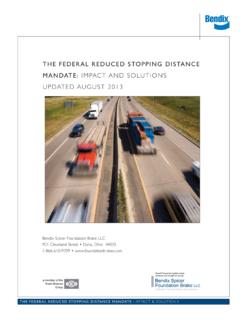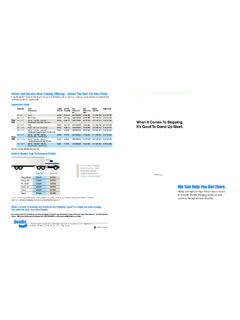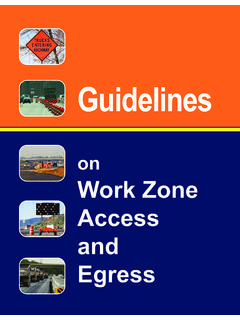Transcription of FLORIDA PEDESTRIAN LAW ENFORCEMENT GUIDE
1 FLORIDA PEDESTRIANLAW ENFORCEMENTGUIDEA review ofFlorida s PEDESTRIAN traffic lawsto help with warnings,citations and crash reportsJuly 2007 All citations are to the 2007 FLORIDA StatutesThis edition is based on a document originallyfunded by a grant from the FLORIDA Department ofTransportation. For more information on bicycleand PEDESTRIAN programs, law ENFORCEMENT andvideos, contact: FLORIDA Bicycle AssociationPO Box 718 Waldo, FL 32694-0718 Phone/fax: s PEDESTRIAN and BicyclingSafety Resource Center111 E Las Olas Blvd, Suite 608Ft Lauderdale, FL 33301 Telephone: 954-762-5286 Fax: 954-762-5278 Toll Free: Safety OfficeFla Department of Transportation605 Suwannee St, MS 82 Tallahassee, FL FLORIDA Visitors & ConventionBureau600 N Broadway, Suite 300 Bartow, FL challenge of PEDESTRIAN traffic ENFORCEMENT .
2 2 UNIFORM TRAFFIC CONTROL LAW SYNOPSIS ..4 Definitions ..4 Laws for pedestrians and drivers ..8 PEDESTRIAN travel along a street or highway ..8No standing in the roadway ..10 Stopping, standing, parking, or driving on sidewalk ..10 Driver duty to PEDESTRIAN at vehicular roadway connections ..11 Driver duty to exercise care to avoid PEDESTRIAN ..11 Crossing a roadway mid-block, not in crosswalk ..12 Crossing a roadway in an unsignalized crosswalk ..13 Crossing a roadway in a signalized crosswalk ..15 Crossings by visually or mobility impaired pedestrians ..20 PRIORITIES FOR ENFORCEMENT & AWARENESS ..21 Enforcing PEDESTRIAN duties to yield ..22 Enforcing motorist duties to yield ..22 Warning pedestrians using wrong shoulder.
3 23 Awareness of, and by, backing drivers ..23 Driver-focused ENFORCEMENT techniques ..24At uncontrolled crosswalks ..24At signalized crosswalks ..272nd edition,(07/2007), FLORIDA Bicycle AssociationThe challenge of pedestriantraffic enforcementMany of FLORIDA 's streets and roads were laid outwhen there was little expectation of future pedestri-an use. New streets and highways were designed tofacilitate motor vehicle travel at higher speeds andto minimize delays at controlled intersections, sothat slowing or stopping to observe the legal duty toyield to pedestrians in crosswalks became an unac-customed inconvenience. Such conditions shaped aroad user culture in which PEDESTRIAN use is usuallysparse outside central business districts, and driv-ers and pedestrians have not acquired the sharedexperience that informs a sense of mutual obliga-tions.
4 Traffic law ENFORCEMENT must be based on arecognized code of behavior. The challenge ofpedestrian traffic ENFORCEMENT is to promote greaterappreciation and observance of practices con-ducive to PEDESTRIAN safety and mutual traffic principles for pedestrians and driv-ers include: A road user's right of way must be exercisedwith "due care."Traffic laws state who must yield the right of way to2whom, but do not assign an absolute right of , crosswalk markings, lane markings andother traffic control devices do not confer anabsolute right of way for any user. Right of way mustbe exercised in a reasonable manner with "duecare" for the safety of one's self and of other roadusers.
5 Pedestrians may cross at most mid-blocklocations, but must yield outside a crossing outside a crosswalk is allowed if,in either direction, the nearest intersection isunsignalized. When crossing mid-block, a pedestri-an must yield to any approaching driver, exceptwhen crossing in a marked crosswalk. A driver is obliged to yield the right of way toa PEDESTRIAN lawfully crossing in a yielding requires stopping if the crossingpedestrian is in the driver's lane, the lane into whichthe driver is turning, or an adjoining lane. A condi-tion for crossing "lawfully" is that the pedestrianbegan crossing when it was legal to do so. A cross-walk is legally present on each leg of an intersectionexcept where crossing is prohibited by are left unmarked at most unsignalizedintersections.
6 If a sidewalk is provided, a PEDESTRIAN travel-3ing along a street or road is obliged to use it ifpractical, otherwise to keep as far left as practi-cal on the shoulder or other area available onleft side of the a highway, a shoulder is generally graded. On astreet with curbs, the leftmost graded area is simplythe leftmost portion of the roadway pavement, notincluding the TRAFFIC CONTROLLAW SYNOPSISS ectional citations not otherwise identified are tothe FLORIDA Uniform Traffic Control Law (Chapter316, FLORIDA Statutes).DefinitionsCROSSWALK: "(a) That part of a roadway at anintersection included within the connections of thelateral lines of the sidewalks on opposite sides ofthe highway, measured from the curbs or, in theabsence of curbs, from the edges of the traversableroadway," or "(b) Any portion of a roadway at anintersection or elsewhere distinctly indicated forpedestrian crossing by lines or other markings onthe surface" [ (6)].
7 4 For purposes of the driving task, crosswalks mustbe assumed to be in place across both theapproach and departure legs of an intersection,regardless of whether markings are present, sincea driver at the critical decision distance for yieldingcan usually not determine whether the crossingstreet has sidewalks. A legal crosswalk extendingthe sidewalk corridor across an intersection leg ispresumed to be present unless the responsibleauthority has closed the crosswalk and postedsigns to that : This commonly used term does notappear in traffic codes. It is generally understood to5mean crossing a roadway in a manner that violatestraffic law, especially (1) crossing mid-blockbetween two adjacent signalized intersections and(2) entering an unsignalized crosswalk when anapproaching driver is so close as to make it difficultfor him to take evasive ON UNIFORM TRAFFIC CONTROLDEVICES (MUTCD): manual published by theFederal Highway Administration and adopted by theFlorida Department of Transportation as the "manu-al of uniform traffic control devices which definesthe uniform system [of "traffic control devices foruse on the streets and highways of the state"]", pur-suant to The MUTCD is online.
8 "Any person afoot" [ (28)].By custom, this is understood to include "a personafoot, in a wheelchair, on skates, or on a skate-board" (meaning of " PEDESTRIAN " as used in theMUTCD, Section ) as well as a person on afoot-powered scooter (nothing in FLORIDA Statutesindicates otherwise). A person operating a bicycleon and along a sidewalk or crosswalk has the rightsand duties applicable to a PEDESTRIAN under thesame circumstances, but must yield to pedestriansand give an audible warning before passing one6and remains subject to bicycle equipment require-ments ( ). A person may operate an elec-tric personal assistive mobility device (Segway ) ona sidewalk subject to the duty to yield to pedestriansand to give an audible warning before passing; noother duties are explicitly assigned to EPAMD oper-ators, except the requirement for an operator underthe age of 16 to wear a bicycle helmet [ ].
9 ROADWAY: "That portion of a highway improved,designed, or ordinarily used for vehicular travel,exclusive of the berm or shoulder. In the event ahighway includes two or more separate roadways,the term 'roadway' as used herein refers to anysuch roadway separately, but not to all such road-ways collectively" [ (42)].SHOULDER: not defined in FLORIDA Statutes, butgenerally understood to be the (graded) portion of ahighway contiguous with the traveled way thataccommodates stopped vehicles, emergency use,and lateral support of base and surface pavementcourses (American Association of State Highwayand Transportation Officials). Shoulders may bepartially or entirely : "That portion of a street between thecurbline, or the lateral line, of a roadway and the7adjacent property lines, intended for use by pedes-trians" [ (47)].
10 The public right-of-wayreservation typically includes width for sidewalksand utilities. Unpaved sidewalks (beaten paths orother firm surfaces) may be practical for somepedestrian use, but generally do not meet technicalprovisions for "accessible trails" or "accessible[ PEDESTRIAN ] routes" as defined in federal accessibil-ity standards and for pedestrians and driversPEDESTRIAN TRAVEL ALONG A STREETOR HIGHWAYW here sidewalks are provided, no PEDESTRIAN shall,unless required by other circumstances, walk alongand upon the portion of a roadway paved for vehic-ular traffic [ (3)]. Where sidewalks are notprovided, a PEDESTRIAN walking along and upon ahighway shall, when practicable, walk only on theshoulder on the left side of the roadway in relationto the PEDESTRIAN 's direction of travel, facing trafficwhich may approach from the opposite direction[ (4)].




